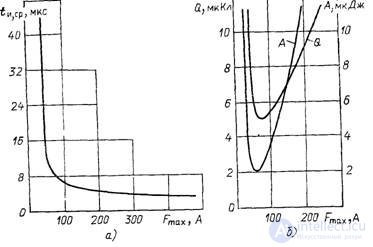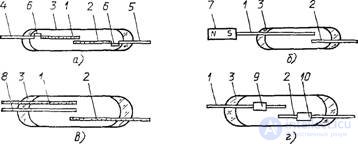Lecture
Gezakon - sealed memory contact. Another type of reed relays, the main distinguishing feature is the preservation of its position (on / off) after the removal of the magnetic field. To switch to such relays, it is necessary to apply a pulse of reverse polarity, for demagnetization of the coret core.
Gezakon - sealed memory contact. It is a type of reed switch. A distinctive feature of the Gezacon is to maintain the position (on / off) after removing the control magnetic field.
The position after the removal of the magnetic field is preserved due to the fact that, at the gezacon, the movable part of the contact spring is made of magnetic material with a rectangular hysteresis loop, which has sufficient magnetization to keep the contact in a closed state
11.5. MERCED RELAYS
The simplest reed relay with magnetic memory is shown in Fig. 11.17, a. Two elements of magnetic memory (EMF) 1 and G are adjacent to the CS of the reed switch 3. The EMFs are made of so-called remanent materials. These materials are characterized by the squareness of the hysteresis loop, a sufficiently high residual induction and high magnetic energy. Unlike hard magnetic alloys used for the manufacture of permanent magnets, remanent materials have a very short magnetization reversal time in the range of 10–50 μs.

Fig. 11.17. Magnetic reed relays
The residual magnetic flux generated by the EMF can be used to keep the reed switches in a closed state after de-energizing the control windings. Magnetic memory relays are often called ferrides. When a control pulse appears and the windings 2 and 2 'turn on consistently, the magnetic flux created by them passes through the CS and both EMFs that are magnetized. After the passage of the pulse, the CS attracts due to the flux of residual induction of the EMF. To turn off the relay, a current pulse of the same polarity and amplitude is supplied to the winding 2, and the same amplitude and reverse polarity is supplied to the winding 2 '. Due to the difference in the MDS windings, demagnetization of the electromagnetic field and a decrease in the magnetic flux in the gap between the CS occurs, and they open. For reliable control, the duration of the current pulse is taken to be 100-300 µs.
To reduce the minimum required release MDS pulse, a magnetically soft shunt 4 is installed in the zone of the working gap of the reed switch (Fig. 11.17,6). When applying bipolar pulses to windings 2 and 2 ', the magnetic flux closes through the CS, magnetic shunt 4 and EMF, bypassing the working gap of the reed switch.
393

Fig. 11.18. Dependence of the duration and duration of the MDS pulse (a), the amount of electricity Q and the energy consumed A (b) on the amplitude of the MDS F
When a pulse is applied to the operation of the relay, the EMF is magnetized, the CS coming closer. After their collision, contact vibration begins, which lasts 0.5-2.5 ms. The total response time of the relay with memory 1 — 3ms. In the Gezacons (Fig. 11.20), it is less (1-2 ms).

Fig. 11.20. The design of the gezakonov :
1, 2, 8 — contact cores; 3 - cylinder; 4, 5 — conclusions; 6 - connecting plate; 7 - permanent magnet; 9. Id - EMF
Two control windings are installed on the gas tanks. If the windings are agreed upon, the CS windings are magnetized and shorted. To open it, it is necessary to change the polarity of the pulse in one of the windings, which leads to demagnetization of the CS.
In the case of fig. 11.20, in control comes from a single source of bipolar pulses. Through pin 1 closes the flow of the polarizing permanent magnet 7. When applying a control pulse that creates a magnetic field, consistent with the magnetic field of the permanent magnet, these fields are added and the CS are closed. When applying a counter pulse, the CS is demagnetized and opened.
The switching gezakon (fig. 11.20, c) has two control windings. When the windings of KS 1 and 2 are consistently turned on, they are magnetized according to and CS 8 is attracted to CS 2. When the pulse polarity changes in one of the windings, the direction of magnetization of one of the CS and CS 8 is attracted to CS /.
In the gezacon in fig. 11.20, g EMF is made in the form of tubes 9, 10, worn on the COP 7 and 2. When the control windings are agreed upon, the EMP tubes 9 and 10 are magnetized according to and the CS are closed. To turn off the reed switch in one of the windings, the polarity of the pulse must be changed.
Comments
To leave a comment
Sensors
Terms: Sensors